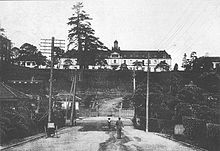Army Officer School (Japan)
At the Army Officer School of Japan ( Japanese 陸軍士 官 学校 , Rikugun Shikan Gakkō ), also the main cadet institute , the officer training of the Imperial Japanese Army was carried out. It offered a foundation course for graduates from regional cadet schools and middle schools and a secondary course for officer cadets .
history
The Army Officer School was established in Kyoto in 1868 under the name Heigakkō and renamed Rikugun Shikan Gakkō in 1874 and relocated to Ichigaya, Tokyo . From 1898 it was subordinate to the Army Education Administration.
In 1937 the school was split up. The secondary course was to Sagamihara in Kanagawa Prefecture moved while the Basic Course by Asaka in Saitama Prefecture was moved. The celebrations for the 50th graduation class on December 20, 1937 were already held in the new premises in Sagamihara and attended by Tennō Hirohito , among others . In 1938, training for army air force officers was outsourced to a separate school.
From June 1945, due to the intensified Allied air raids on Japan, the school was evacuated as a precaution and the approximately 3,000 students were transferred to a long-term field exercise in Nagano Prefecture .
After Japan surrendered in September 1945, a battalion of the 1st US Cavalry Division took over the school grounds from the few remaining guards. The school was formally closed at the end of the year. The school campus in Sagamihara is currently part of a base of the United States Forces Japan .
The National Defense Academy of the Japanese Ground Self-Defense Forces can serve as the successor organization .
education
Between 1937 and 1945, 18,476 cadets attended the army officer school.
Candidates for the school were usually among the graduates of one of the three-year regional cadet schools ( 陸軍 幼年 学校 , Rikugun Yōnen Gakkō ) in Tokyo, Osaka , Nagoya , Hiroshima , Sendai and Kumamoto , which referred about 300 graduates annually around 1910, or among middle school graduates who met the physical and mental requirements. Visits to the Army Cadet Centers were mainly reserved for the children of officers or soldiers who had fallen in combat. Active soldiers under 25 years of age were also able to attend the officer's school, provided they passed the necessary tests.
In addition to theoretical training, martial arts and riding were also taught. After two years of basic training, the graduates were transferred to an infantry regiment for eight months with the rank of sergeant in order to familiarize themselves with army life and their first own command duties. This was followed by 20-month secondary training, which was completed with another four-month assignment in her infantry regiment. Insisted the cadet his final exam, he was in the rank of second lieutenant transferred to the army and was given the opportunity at the Army College to study.
During its existence, many foreign cadets also underwent training at the officer school, mainly from China . Among them was the future President of the Republic of China , Chiang Kai-shek .
literature
- US Department of War: Handbook on Japanese Military Forces, TME-E 30-480. Louisiana State University Press, 1994, ISBN 0-807-12013-8 .
Web links
- Handbook on Japanese Military Forces, TM-E 30-480 (1945 ), Retrieved February 15, 2011
Individual evidence
- ^ A b Karl Ludwig von Oertzen, Heinrich von Löbell , Gerhard von Pelet-Narbonne : Armament and disarmament. A survey of the army and warfare of all countries . tape 38 . ES Mittler & Sohn, 1911, p. 132 ( limited preview in Google Book search).
- ↑ Guido von Frobel : Military weekly paper . tape 95 , no. 84 . ES Mittler & Sohn, 1910, p. 2004 ( limited preview in Google Book Search).
